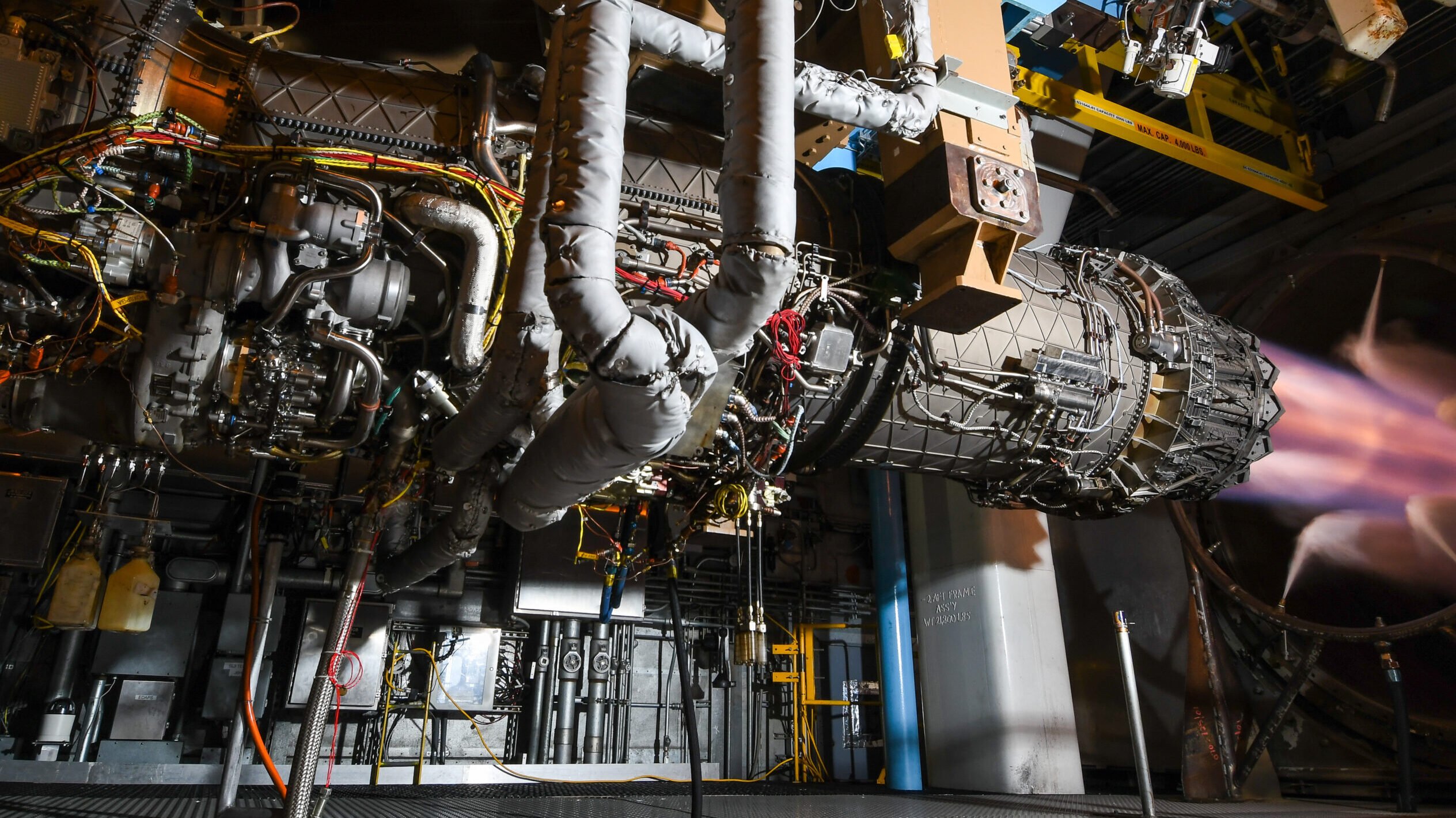
A Pratt & Whitney F135 engine undergoes accelerated mission testing in Sea Level Test Cell 3 at Arnold Air Force Base, Tenn., Nov. 15, 2021. The F135 is the engine used to power the F-35 Lightning II. (U.S. Air Force photos by Jill Pickett)
Updated 1:20 pm ET 3/13/2023 with comment from Pratt & Whitney, following that of General Electric.
WASHINGTON — In a major victory for incumbent manufacturer Pratt & Whitney, the Air Force has decided not to pursue a new engine for the F-35A in its fiscal 2024 budget request, dashing the hopes of potential competitor General Electric and likely ensuring that Pratt will continue to power the global Joint Strike Fighter enterprise for years to come.
The new engine was simply too costly to develop, Air Force Secretary Frank Kendall said in a Friday budget briefing, even though he stated that the new powerplant “was a really good fit” for the service’s F-35A. As a result, the service’s FY24 budget request seeks $245 million to fund an engine upgrade offered by Pratt and will shutter the Air Force’s Adaptive Engine Transition Program (AETP).
The problem largely came down to the fact that while there was “some discussion” about fitting the new engine with the Navy’s carrier-launched F-35C variant, getting it to work with the Marine’s short take-off and vertical landing (STOVL) F-35B variant was “going to be very, very difficult, if not impossible.” The lack of commonality risked disrupting the engine’s shared international supply chain, a hallmark for the program and a strong selling point for international customers of the aircraft.
The Air Force’s verdict rests on “the combination of affordability and the fact that the Air Force, with the F-35A variant, was the only service that was really seriously interested in AETP,” Kendall said.
For more FY24 budget coverage, click here.
Kendall added that if the development cost was lower, the Air Force may have found the space in its budget to fund the engine for its jets alone, “but at the level of several billion dollars to do that [engineering and manufacturing development], we couldn’t get there.”
Launched in 2016, AETP has carried Pratt & GE through prototyping activities to develop a new engine for the F-35A. Officials considered re-engining the fighter with the powerplants — known as “adaptive engines” that use a third stream of air to enable more fuel-efficient flight while cruising and higher thrust when in combat — to provide greater power and thermal management as the F-35 program moves to enhance the fighter with a suite of capabilities known as Block 4.
GE backed the adaptive option, once again seeking a chance to supplant Pratt as the manufacturer for the F-35’s engine after Congress canceled a parallel engine development effort in 2011. The company argued that potential conflict in the Indo-Pacific requires an engine with greater capabilities and claimed that GE’s AETP prototype, called the XA100, could extend the fighter’s range by 30%, improve its thrust by 10% and double thermal management capacity compared to the current engine.
“This budget fails to consider rising geopolitical tensions and the need for revolutionary capabilities that only the XA100 engine can provide by 2028,” a GE spokesperson said in a statement. “Nearly 50 bipartisan Members of Congress wrote in support of advanced engine programs like ours because they recognize these needs, in addition to the role competition can play in reducing past cost overruns. The XA100 engine is ready to power U.S. warfighters today and in the future.”
Though Pratt developed its own AETP prototype, called the XA101, in case officials decided to compete a new engine, the company has downplayed the idea of a brand new design, instead championing a modernization plan called the Engine Core Upgrade (ECU), which executives described as a modular enhancement to Pratt’s existing F135 powerplant.
In a briefing with reporters in December, F135 Engine Program Vice President Jen Latka said ECU could increase the fighter’s range and thrust by 7 percent, double the current engine’s thermal management and be ready to plug into the fighter in 2028.
Latka also claimed ECU would be cheaper to develop — $2.4 billion, compared to $6.7 billion for an adaptive engine — and would double lifecycle cost savings over the adaptive engine to the tune of $40 billion.
The F-35 Joint Program Office conducted its own business case analysis (BCA) for the engine modernization plan alongside a separate one run by the Air Force, though the results of the two studies have not been made public.
Kendall said ECU would “provide acceptable levels of increased performance for all three services,” adding that although AETP will be discontinued, the program “has set the basis” for the service’s Next Generation Adaptive Propulsion (NGAP) engine that will power the secretive Next Generation Air Dominance system.
Both Pratt and GE are currently participating in the NGAP program, as well as airframe primes Lockheed Martin, Northrop Grumman and Boeing. According to John Sneden, who heads the Air Force’s propulsion directorate, a down-select for NGAP could come as soon as 2024.
Pratt said today the company is “pleased to see the President’s Budget includes funding for the Engine Core Upgrade. All F-35 variants need fully-enabled Block 4 capabilities as soon as possible, and with this funding, we can deliver upgraded engines starting in 2028. The F135 ECU saves billions, which ensures a record quantity of F-35s can be procured. It also ensures funding will be available to develop 6th generation propulsion for the Air Force’s Next Generation Air Dominance Platform.”
Congressional patrons, many hailing from Pratt and GE’s respective home states of Connecticut and Ohio, have previously secured funding for both companies’ preferred approaches: Pratt was awarded a $115 million contract for ECU in November, followed by a $203 million award to GE for risk reduction activities for AETP. In the compromise FY23 National Defense Authorization Act, lawmakers additionally ordered the Government Accountability Office to audit the JPO’s BCA.
Those same delegations mean the Air Force’s decision may face pushback as debate around the budget kicks off, as Connecticut-based Pratt has strong local support to pull from. Sen. Chris Murphy is on the Senate defense appropriations subcommittee while Sen. Richard Blumenthal is on the Senate Armed Services Committee. On the House side, Rep. Rosa DeLauro is the top Democrat on the House Appropriations Committee and Rep. Joe Courtney is a long-tenured member of the House Armed Services Committee.






















